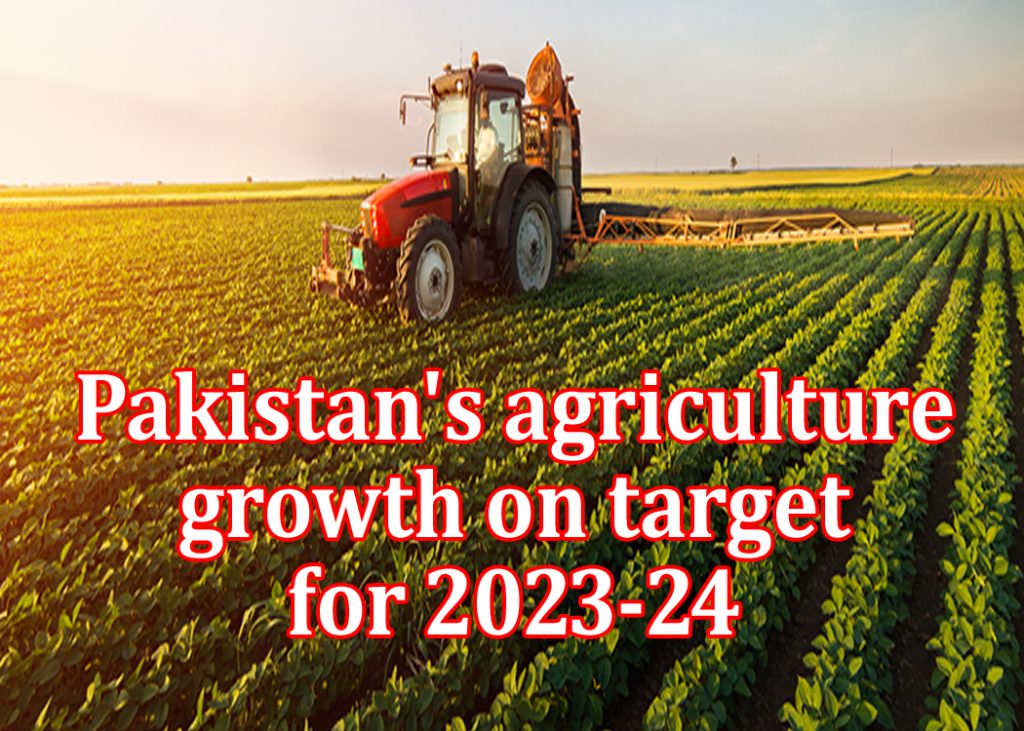
AVN Report
ISLAMABAD: Pakistan is making remarkable strides towards reaching its agriculture growth target of 3.5 percent for the fiscal year 2023-24, thanks to significant advancements in major crop production, particularly in cotton and rice. These developments are expected to make a substantial contribution towards achieving the targeted Gross Domestic Product (GDP) growth rate of 3.5 percent.
A senior official from the Ministry of National Food Security and Research (MNFS&R) affirmed that the surge in cotton and rice production, coupled with growth in minor crops and the livestock sector, is set to play a pivotal role in achieving the agriculture growth objective.
The agriculture sector, which accounts for 22.9 percent of the GDP and generates 37.4 percent of employment, plays a critical role in ensuring food security and supplying raw materials to the industrial sector.
Notably, cotton production for the fiscal year 2023-24 is estimated at a staggering 11.5 million bales, covering 2.4 million hectares, marking an impressive 126.6 percent increase compared to the previous year. Simultaneously, rice production for the same period is projected to reach 8.64 million tons, spanning 3.35 million hectares, demonstrating a remarkable increase of 12.7 percent in area and 18 percent in production compared to the previous year.
While sugarcane production is expected to decline slightly, with estimates at 78.5 million tons from an area of 1.7 million hectares, indicating a decrease of 10.74 percent in area and 10.9 percent in production compared to the previous year, the overall outlook remains promising.
Maize production for 2023-24 is reported at 10.3 million tons, reflecting a 6.07 percent reduction in production and a 2.40 percent decrease in area compared to the previous year. Furthermore, the production of Mung beans is projected to be 143.6 thousand tons, covering 198 thousand hectares, showing an increase of 6.42 percent. Maash production for the same period is estimated at 5.28 thousand tons, spanning 7.36 thousand hectares, reflecting a growth of 24.65 percent. Chilies production is expected to reach 1.36 thousand tons, covering an area of 122.1 thousand hectares, indicating an increase of 2.33 percent.
In the animal husbandry section of MNFS&R, it is anticipated that the livestock’s contribution to the agriculture sector will increase by a significant 64 percent.
However, despite these positive developments in agriculture, there remains consensus among international organizations such as the International Monetary Fund (IMF), World Bank, Asian Development Bank (ADB), and independent economists that Pakistan is unlikely to meet the budgeted GDP growth target of 3.5 percent for the current fiscal year. This is due to factors such as high-interest rates, low imports owing to foreign exchange reserves shortages, and high inflation.
The IMF has projected a GDP growth rate of 2.5 percent for Pakistan in 2024, with the possibility of revision based on first-quarter data submitted for the Stand By Arrangement (SBA) first review. The World Bank and ADB have forecasted GDP growth rates of 1.7 percent and 1.9 percent, respectively, for 2023-24.
Former Finance Ministry Adviser Dr. Ashfaque Hassan Khan projected a GDP growth rate of around 2 percent, citing high-interest rates, low imports, and reduced investment as factors contributing to sluggish economic activity and affecting production.
While challenges persist on the economic front, Pakistan’s agriculture sector is undeniably on an upward trajectory, poised to make a substantial contribution to the nation’s growth and development.
In other economic news, the overall Large Scale Manufacturing Industries (LSMI) output for July-August 2023-24 showed a growth of 0.50 percent compared to the same period the previous year. In August 2023, there was a 2.52 percent growth compared to August 2022 and an 8.44 percent growth compared to July 2023. It’s worth noting that the growth rate for the current year is based on a very low base from the previous year when LSMI registered a negative growth of 10.26 percent compared to the same period of 2021-22.





